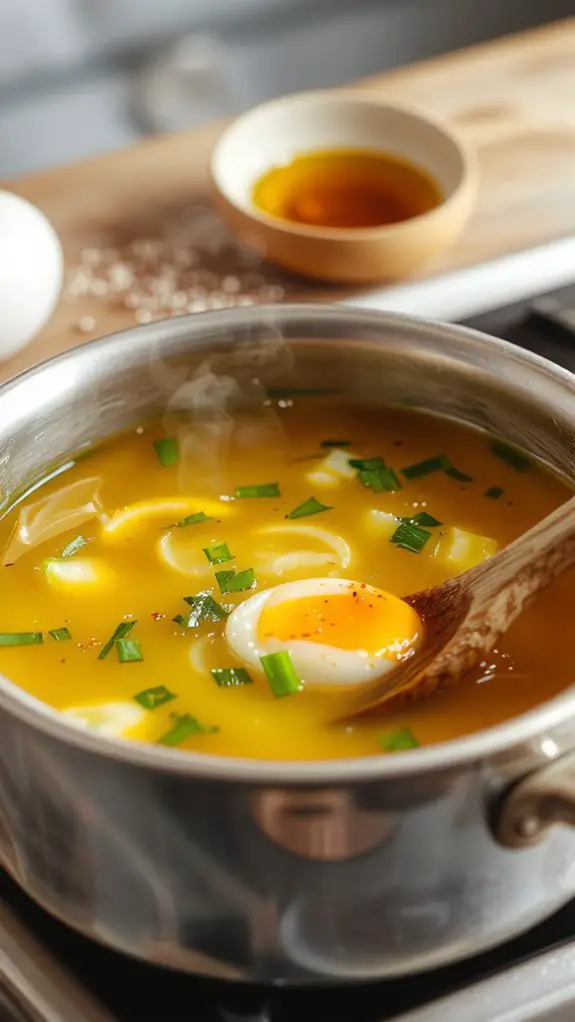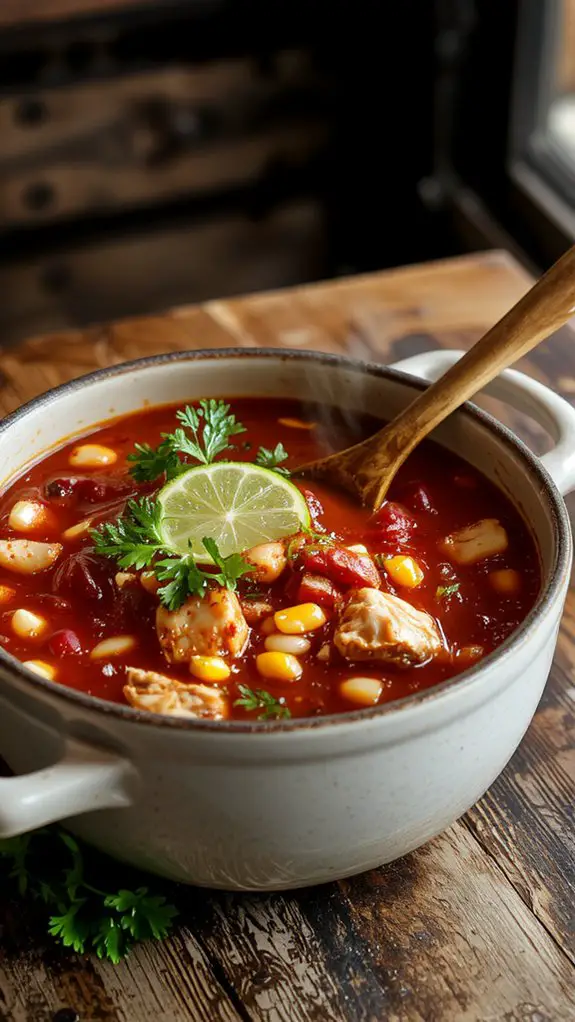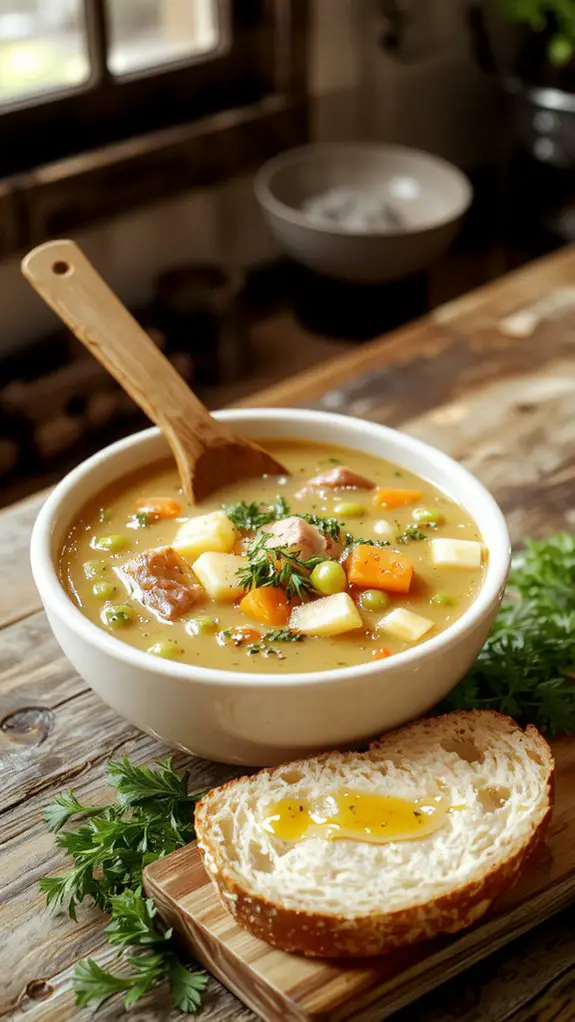Recipe
This potato soup is the ultimate cozy meal you’ll want to make on repeat—it’s creamy, comforting, and downright delicious. What sets it apart? Melt-in-your-mouth potatoes, a velvety broth, and just the right touch of garlic and herbs that make every spoonful irresistible.
I’ve whipped this up countless times, whether it’s for a quick weeknight dinner or to impress a crowd, and it’s always a hit. The secret? Simmering the potatoes low and slow until they’re tender and rich, then blending just enough to create that dreamy, smooth texture with a bit of rustic bite.
Toss in some crispy bacon or sharp cheddar for extra indulgence, and you’ve got a bowl of pure comfort that’ll warm you from the inside out. Trust me, once you try it, this soup will earn a permanent spot in your recipe rotation.
Ingredients
Start with fresh, high-quality ingredients to guarantee your potato soup is rich, creamy, and full of flavor. Opt for starchy potatoes like Russets for that perfect velvety texture, and don’t skimp on the aromatics—they’re the foundation of the soup’s depth. Here’s what you’ll need:
- Potatoes – Russet potatoes are ideal for their high starch content, which creates a naturally creamy texture when cooked. For a heartier bite, Yukon Golds work well too.
- Onion – Yellow onions are my go-to for their sweet, mellow flavor. A finely chopped shallot can be a great alternative.
- Garlic – Fresh garlic adds a punch of flavor. Use 3-4 cloves for a robust taste.
- Butter – Unsalted butter is key for sautéing the aromatics and adding richness. If you’re dairy-free, swap in olive oil.
- Flour – Just a tablespoon to thicken the soup. Gluten-free flour works if needed.
- Chicken or Vegetable Broth – Homemade broth is gold, but a high-quality store-bought version is fine. Use vegetable broth to keep it vegetarian.
- Heavy Cream – For that luxurious creaminess. Half-and-half or whole milk can substitute, but the richness won’t be the same.
- Salt and Pepper – Essential for seasoning. Add them in layers to build flavor.
- Optional Garnishes – Chives, bacon bits, shredded cheese, or a dollop of sour cream take this soup to the next level.
Pro Tip: Grate a little nutmeg into the soup—it’s a secret trick to enhance the creamy, earthy flavors.
Non-Negotiable: Don’t skip the butter; it’s the foundation for that rich, silky texture.
Feel free to tweak the garnishes based on what you have on hand—personalization is part of the fun!
How to Make the Best Hearty Potato Soup Recipe

– Prep the potatoes: Peel and dice 4 medium russet potatoes into 1-inch cubes. Uniform pieces promote even cooking.
Pro tip: Soak diced potatoes in cold water for 10 minutes to remove excess starch, which prevents a gummy texture.
– Sauté the aromatics: In a large pot, melt 3 tablespoons of butter over medium heat. Add 1 diced onion and 2 minced garlic cloves, stirring until translucent (about 5 minutes).
This builds the flavor base—don’t rush it! Watch out: Browning the garlic can make it bitter.
– Add the potatoes and broth: Drain the potatoes and add them to the pot with 4 cups of chicken or vegetable broth. Bring to a boil, then reduce to a simmer. Cook for 15–20 minutes until potatoes are fork-tender.
Visual cue: Potatoes should break apart easily when pressed.
– Thicken the soup: Use a potato masher to lightly crush some potatoes for texture.
For creaminess, stir in 1 cup of heavy cream or whole milk. Pro tip: Warm the cream slightly before adding to prevent curdling.
– Season and finish: Stir in 1 teaspoon salt, ½ teaspoon black pepper, and ½ teaspoon dried thyme. Taste and adjust—undersalting is a common mistake!
For extra richness, top with shredded cheddar or crispy bacon.
– Serve hot: Ladle into bowls and garnish with fresh chives or parsley.
Leftovers thicken when chilled; thin with broth when reheating. Flexibility: Swap russets for Yukon Golds for a buttery flavor.
Nutrition
Potato soup is a comforting and nutritious dish, perfect for any meal. Here’s a breakdown of its nutritional value per serving.
| Nutrient | Amount per Serving |
|---|---|
| Calories | 250 kcal |
| Fat | 10 g |
| Carbohydrates | 35 g |
| Protein | 6 g |
| Fiber | 4 g |
| Sodium | 600 mg |
Chef Tips
While the nutritional value of potato soup makes it a satisfying choice, I’ve found that a few simple techniques can elevate its flavor and texture.
Use starchy potatoes like russets for creaminess, and don’t overcook them—they should hold shape.
Sauté onions until golden for depth. Blend half the soup for thickness, leaving chunks.
Finish with a splash of cream and fresh herbs for brightness. These tweaks make all the difference.
Frequently Asked Questions
Can I Freeze Potato Soup?
Yes, I can freeze potato soup. I make sure it’s completely cooled before transferring it to airtight containers or freezer bags, leaving some space for expansion. I label and date them, then store for up to three months.
How Long Does Potato Soup Last in the Fridge?
I’d say potato soup lasts 3-4 days in the fridge if stored properly. Make sure it’s in an airtight container and cooled before refrigerating. If it smells or looks off, I’d toss it.
Can I Use Sweet Potatoes Instead?
Yes, I can use sweet potatoes instead; they’ll add a slightly sweeter, richer flavor. I’d adjust seasonings to complement the sweetness and keep in mind they cook faster, so I’d check them often to avoid mushiness.
What Can I Substitute for Heavy Cream?
I’d substitute heavy cream with whole milk, half-and-half, or coconut milk for a dairy-free option. A mix of milk and melted butter works too. Evaporated milk’s another creamy alternative if you’ve got it on hand.
Is Potato Soup Gluten-Free?
Yes, potato soup is gluten-free if I use gluten-free ingredients like broth and thickeners. I’d check labels for hidden gluten in seasonings or additives. If I skip flour or wheat-based products, it’s safe.










